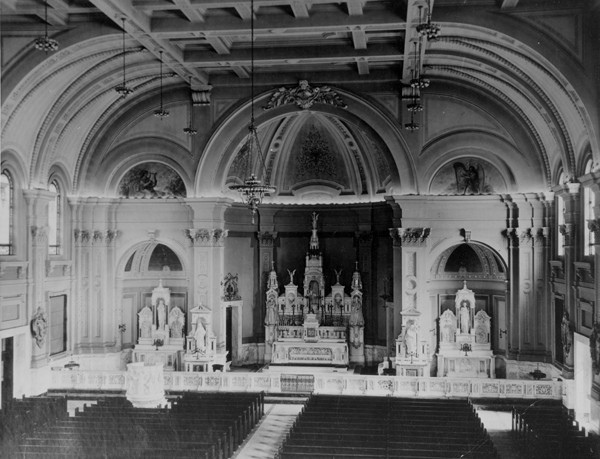Saint Colman Catholic Church

St. Colman Catholic Church, located on West 65th Street near Lorain Avenue, was founded in 1880 as a response to the rapidly growing Irish immigrant population on Cleveland's West Side. Father Eugene M. O'Callaghan, former pastor of the predominately Irish St. Patrick's Catholic Church, held the first mass in a rented home off of Gordon Street (W 65th Street). Later that year, the first church was constructed on Gordon Street and the home was converted into St. Colman School. With over 1,000 worshipers in 1883, the church was expanding in both its size and the role it played within the surrounding community. A new school was built on Gordon Street in 1885, and a convent was constructed for the Sisters of St. Joseph to begin their residency the following year. By 1904, a larger three-level schoolhouse opened that included a 1,000 seat auditorium in the basement.
Taking four years to construct, St. Colman Catholic Church opened its doors in 1918. The classically styled structure could accommodate 2,800 people. St. Colman continued to expand, with a convent added in 1921, and both a second school and rectory constructed in 1930. The Church continued to act as the centerpiece of the neighborhood's Irish community until the middle of the century.
The West Side Irish community remained stable until the end of World War II. Soon after, however, the community dissolved as a result of the general exodus of Cleveland residents away from the urban core. In this changing environment, St. Colman Church evolved to meet the needs of an increasingly diverse and less prosperous community. With the 1904 school being closed and demolished in 1974, St. Colman opened one of the West Side's first preschools in its 1930 school building. Additionally, the church expanded its role ministering and providing social services to the outlying neighborhood through the development of a recovery program, literacy projects, an outreach ministry, and HUD-supported housing for senior citizens.
In an effort to downsize the Cleveland Catholic Diocese, Bishop Richard Lennon announced that St. Colman would merge with St. Stephen in March 2009. This order led to local grassroots efforts by the community to get Lennon to reconsider his decision. Rev. Bob Begin visited Lennon on two occasions to make the case for St. Colman. A flurry of appeal letters were sent to Lennon, arguing that the parish's social services had a tremendous impact on the urban poor, and that the church was financially stable. The works done by both Begin and St. Colman’s parishioners convinced Lennon to keep the church open.
However, not every church was spared closure. St. Emeric Church closed on June 30, 2010, leaving hundreds without a parish. Enter St. Colman; Rev. Begin collaborated with St. Emeric’s parishioner Eva Szabo, to hold monthly masses at St. Colman. Begin started learning Magyar, a Hungarian language, in order to prepare for St. Emeric’s churchgoers. He told the Plain Dealer, “I’ll learn to speak Hungarian enough to do the prayers.” The masses continued while Szabo and others continued to fight for their parish.
When Rev. Begin turned 75, he had to retire under church law. St. Colman’s parishioners disagreed, wishing Begin could stay longer. In their efforts, they submitted over 3,000 signatures and letters to Lennon to change his mind about Begin’s retirement. Lennon listened and offered to allow Begin to work for one more year, which Begin accepted. Begin officially retired in 2014, but continued to help and assist the church and those in need.
Audio
Images





